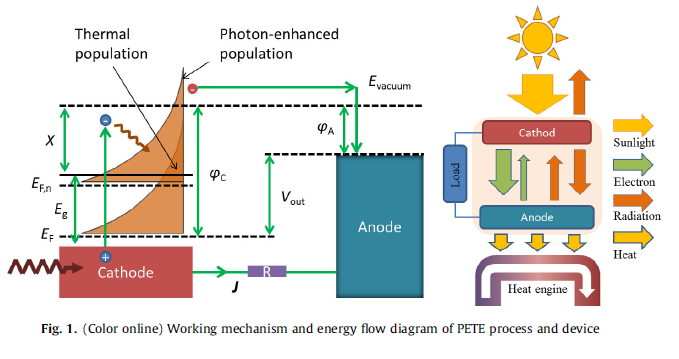A new photovoltaic-thermochemical (PVTC) conceptual system integrating photon-enhanced thermionic emission (PETE) and methane steam reforming is proposed. Major novelty of the system lies in its potential adaptivity to primary fuels (e.g. methane) and high efficiencies of photovoltaic and thermochemical power generation, both of which result from its operation at much elevated temperatures (700–1000 °C) compared with conventional photovoltaic-thermal (PVT) systems. Analysis shows that an overall power generation efficiency of 45.3% and a net solar-to-electric efficiency of 39.1% could be reached at an operating temperature of 750 °C, after considering major losses during solar energy capture and conversion processes. The system is also featured by high solar share (37%) in the total power output, as well as high energy storage capability and very low CO2 emissions, both enabled by the integration of methane reforming with photovoltaic generation at high temperatures.
A new photovoltaic-thermochemical (PVTC) hybrid system for efficient solar power generation has been proposed and analyzed. The high operating temperature of the PV part, i.e. a photon enhanced thermionic emission (PETE) module, makes it possible for primary fossil fuel (i.e. methane) to be integrated with (unconventional) PV generation for cascaded utilization of solar energy and thus efficient power generation with solar energy, which in a large part relates to the strong endothermicity of methane reforming reaction and to the leverage effect that enhances the energy level of solar thermal energy at the cost of the even higher energy level of methane. The integration of high-temperature PETE and methane thermochemistry results in distinct advantages as compared with both conventional PVT systems that do not involve fuels in the thermal part and our previously reported methanol based PVTC system. Such advantages include: (1) high efficiency, with overall electric efficiency of 45.3% and net solar-to-electric (NSE) efficiency of 39.1%; (2) high energy storage ratio, up to 80%; (3) high fossil energy saving and low CO2 emission, with ~50% of fossil energy saved and ~99% of the CO2 emission captured. Based on these advantages, the PETE-MSR hybrid system proposed in this study might provide a promising approach for efficient and scalable solar power generation integrated with low carbon utilization of primary fossil fuels.
